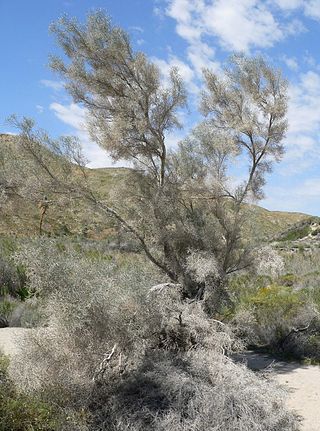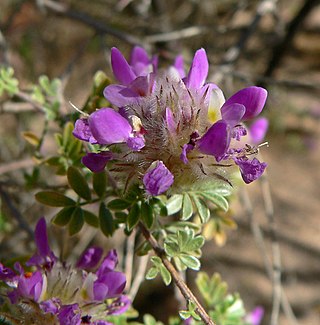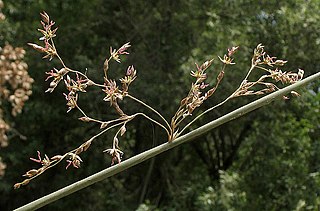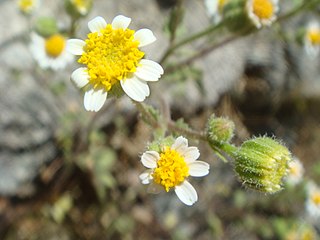The common name indigo bush can refer to plants in any of several genera in the legume family, including:

Purple sage has various uses, mostly referring to plants or to Zane Grey's novel Riders of the Purple Sage, set in Utah. There is disagreement about what plant Grey had in mind.

Psorothamnus spinosus, or Delea spinosa, is a perennial legume tree of the deserts in North America. Common names include smokethorn, smoketree, smoke tree, smokethorn dalea, and corona de Cristo.

Psorothamnus is a genus of plants in the legume family. These are shrubs and small trees. Many are known by the general common name indigo bush. Some are referred to as daleas, as this genus was once included in genus Dalea. These are generally thorny, thickly branched, strongly scented bushes. Most species bear lupinlike raceme inflorescences of bright purple legume flowers and gland-rich pods. Psorothamnus species are native to the southwestern United States and northern Mexico. The genus is paraphyletic and it has been proposed that the genus Psorodendron be reinstated to accommodate sections Xylodalea, Capnodendron, and Winnemucca.

Lycium andersonii is a species of flowering plant in the nightshade family, Solanaceae. Its common names include water-jacket, redberry desert-thorn, Anderson thornbush, Anderson's desert thorn, Anderson boxthorn, Anderson lycium, Anderson wolfberry, and squawberry.

Condea emoryi, the desert lavender, is a large, multi-stemmed shrub species of flowering plant in Lamiaceae, the mint family.

Psorothamnus fremontii, the Fremont's dalea or Fremont's indigo bush is a perennial legume shrub.

Dalea pulchra, the Santa Catalina prairie clover or indigo bush, is a perennial shrub or subshrub of the subfamily Faboideae in the pea family-(Fabaceae). It is found in the southwestern United States and Northwestern Mexico in the states of Arizona, New Mexico, Sonora, and Chihuahua, in the Madrean sky islands region and associated areas.

Juncus textilis is a species of rush known by the common name basket rush. It is endemic to California, where it grows along the coast and in the coastal mountain ranges of the southern half of the state.
The Cleghorn Lakes Wilderness is a 39,167-acre (158.50 km2) wilderness area in the southern Mojave Desert. It is located 16 miles (26 km) northeast of Twentynine Palms, California, and 20 miles (32 km) north of Joshua Tree National Park. It is managed by the Bureau of Land Management.

Perityle emoryi is a species of flowering plant in the aster family known by the common name Emory's rockdaisy. It is native to the Southwestern United States, northwest Mexico, and the Baja California Peninsula. It is a common wildflower of the deserts, and can also be found in California coastal regions.

Pilostyles thurberi is a species of endoparasitic flowering plant known by the common names Thurber's stemsucker and Thurber's pilostyles. It is native to the southwestern United States and northern Mexico, where it grows in desert and woodland. In the United States, P. thurberi has been recorded from the states of Arizona, California, New Mexico, Nevada, Texas.

Psorothamnus arborescens is a species of flowering plant in the legume family known by the common name Mojave indigo bush.

Psorothamnus polydenius is a species of flowering plant in the legume family known by the common names Nevada dalea and Nevada indigobush. It is native to the deserts of the southwestern United States from the Mojave Desert in California to Utah.

Psorothamnus schottii is a species of flowering plant in the legume family known by the common name Schott's dalea. It is native to the Sonoran Deserts of northern Mexico and adjacent sections of Arizona and the Colorado Desert in California.

Sphaeralcea emoryi is a species of flowering plant in the mallow family known by the common name Emory's globemallow. It is native to the Southwestern United States, California and Northwestern Mexico. It grows in desert habitat and sometimes disturbed areas such as roadsides.

Lycium pallidum is a species of flowering plant in the nightshade family known by the common names pale wolfberry and pale desert-thorn. It is native to northern Mexico and the southwestern United States. In Mexico it can be found in Sonora, Chihuahua, Zacatecas, and San Luis Potosi. In the United States it occurs from California to Texas and as far north as Utah and Colorado.
Psorothamnus scoparius is a thornless bush in the bean family (Fabaceae), native to North America. It is known as broom smokebush and broom dalea.















